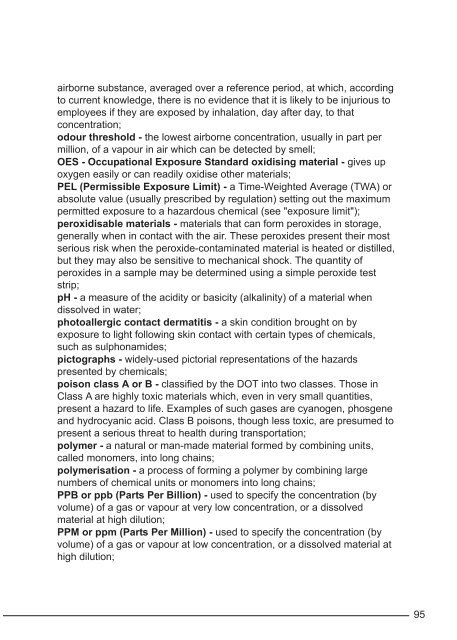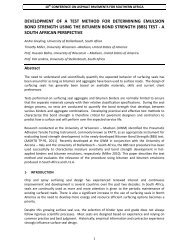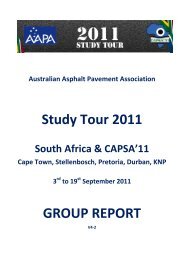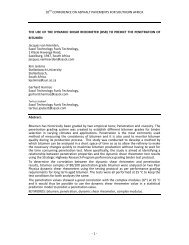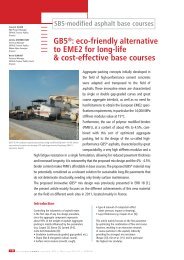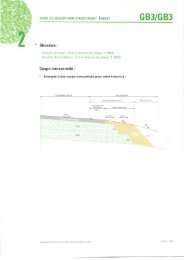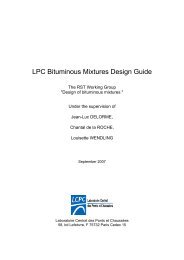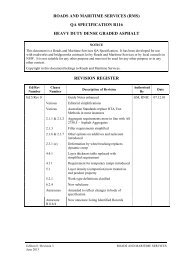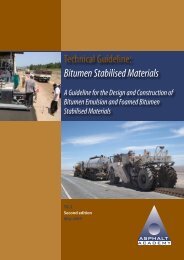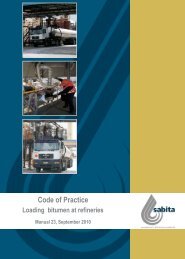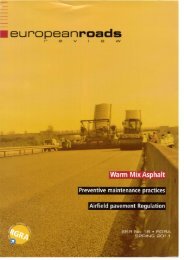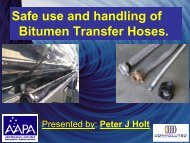Guide to the safe handling of solvents in a bituminous ... - Aapaq.org
Guide to the safe handling of solvents in a bituminous ... - Aapaq.org
Guide to the safe handling of solvents in a bituminous ... - Aapaq.org
- No tags were found...
You also want an ePaper? Increase the reach of your titles
YUMPU automatically turns print PDFs into web optimized ePapers that Google loves.
airborne substance, averaged over a reference period, at which, accord<strong>in</strong>g<strong>to</strong> current knowledge, <strong>the</strong>re is no evidence that it is likely <strong>to</strong> be <strong>in</strong>jurious <strong>to</strong>employees if <strong>the</strong>y are exposed by <strong>in</strong>halation, day after day, <strong>to</strong> thatconcentration;odour threshold - <strong>the</strong> lowest airborne concentration, usually <strong>in</strong> part permillion, <strong>of</strong> a vapour <strong>in</strong> air which can be detected by smell;OES - Occupational Exposure Standard oxidis<strong>in</strong>g material - gives upoxygen easily or can readily oxidise o<strong>the</strong>r materials;PEL (Permissible Exposure Limit) - a Time-Weighted Average (TWA) orabsolute value (usually prescribed by regulation) sett<strong>in</strong>g out <strong>the</strong> maximumpermitted exposure <strong>to</strong> a hazardous chemical (see "exposure limit");peroxidisable materials - materials that can form peroxides <strong>in</strong> s<strong>to</strong>rage,generally when <strong>in</strong> contact with <strong>the</strong> air. These peroxides present <strong>the</strong>ir mostserious risk when <strong>the</strong> peroxide-contam<strong>in</strong>ated material is heated or distilled,but <strong>the</strong>y may also be sensitive <strong>to</strong> mechanical shock. The quantity <strong>of</strong>peroxides <strong>in</strong> a sample may be determ<strong>in</strong>ed us<strong>in</strong>g a simple peroxide teststrip;pH - a measure <strong>of</strong> <strong>the</strong> acidity or basicity (alkal<strong>in</strong>ity) <strong>of</strong> a material whendissolved <strong>in</strong> water;pho<strong>to</strong>allergic contact dermatitis - a sk<strong>in</strong> condition brought on byexposure <strong>to</strong> light follow<strong>in</strong>g sk<strong>in</strong> contact with certa<strong>in</strong> types <strong>of</strong> chemicals,such as sulphonamides;pic<strong>to</strong>graphs - widely-used pic<strong>to</strong>rial representations <strong>of</strong> <strong>the</strong> hazardspresented by chemicals;poison class A or B - classified by <strong>the</strong> DOT <strong>in</strong><strong>to</strong> two classes. Those <strong>in</strong>Class A are highly <strong>to</strong>xic materials which, even <strong>in</strong> very small quantities,present a hazard <strong>to</strong> life. Examples <strong>of</strong> such gases are cyanogen, phosgeneand hydrocyanic acid. Class B poisons, though less <strong>to</strong>xic, are presumed <strong>to</strong>present a serious threat <strong>to</strong> health dur<strong>in</strong>g transportation;polymer - a natural or man-made material formed by comb<strong>in</strong><strong>in</strong>g units,called monomers, <strong>in</strong><strong>to</strong> long cha<strong>in</strong>s;polymerisation - a process <strong>of</strong> form<strong>in</strong>g a polymer by comb<strong>in</strong><strong>in</strong>g largenumbers <strong>of</strong> chemical units or monomers <strong>in</strong><strong>to</strong> long cha<strong>in</strong>s;PPB or ppb (Parts Per Billion) - used <strong>to</strong> specify <strong>the</strong> concentration (byvolume) <strong>of</strong> a gas or vapour at very low concentration, or a dissolvedmaterial at high dilution;PPM or ppm (Parts Per Million) - used <strong>to</strong> specify <strong>the</strong> concentration (byvolume) <strong>of</strong> a gas or vapour at low concentration, or a dissolved material athigh dilution;95


